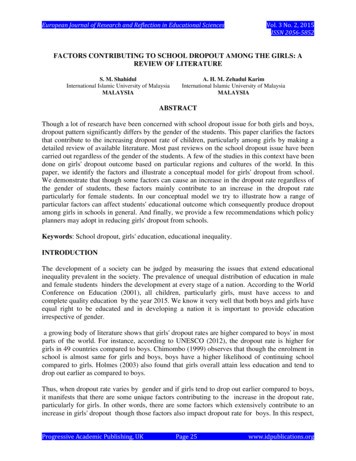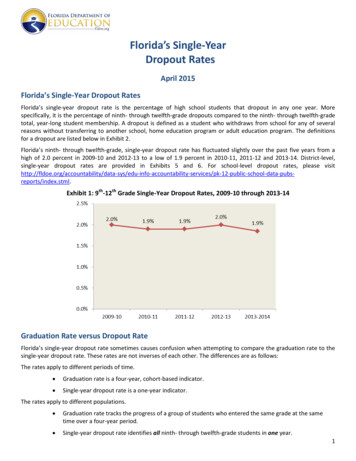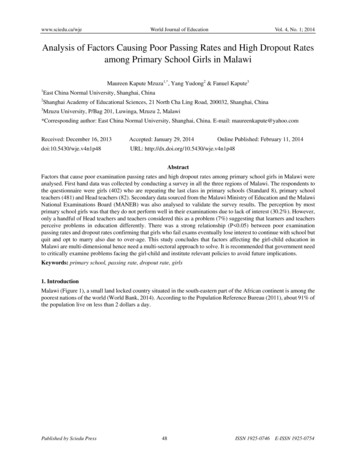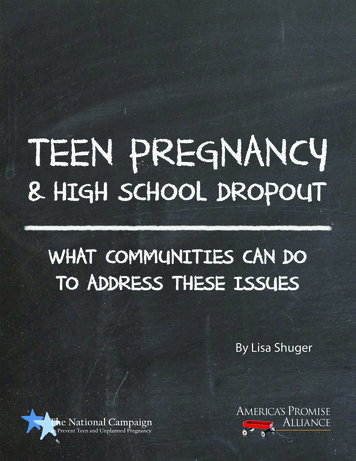
Transcription
European Journal of Research and Reflection in Educational SciencesVol. 3 No. 2, 2015ISSN 2056-5852FACTORS CONTRIBUTING TO SCHOOL DROPOUT AMONG THE GIRLS: AREVIEW OF LITERATURES. M. ShahidulInternational Islamic University of MalaysiaMALAYSIAA. H. M. Zehadul KarimInternational Islamic University of MalaysiaMALAYSIAABSTRACTThough a lot of research have been concerned with school dropout issue for both girls and boys,dropout pattern significantly differs by the gender of the students. This paper clarifies the factorsthat contribute to the increasing dropout rate of children, particularly among girls by making adetailed review of available literature. Most past reviews on the school dropout issue have beencarried out regardless of the gender of the students. A few of the studies in this context have beendone on girls' dropout outcome based on particular regions and cultures of the world. In thispaper, we identify the factors and illustrate a conceptual model for girls' dropout from school.We demonstrate that though some factors can cause an increase in the dropout rate regardless ofthe gender of students, these factors mainly contribute to an increase in the dropout rateparticularly for female students. In our conceptual model we try to illustrate how a range ofparticular factors can affect students' educational outcome which consequently produce dropoutamong girls in schools in general. And finally, we provide a few recommendations which policyplanners may adopt in reducing girls' dropout from schools.Keywords: School dropout, girls' education, educational inequality.INTRODUCTIONThe development of a society can be judged by measuring the issues that extend educationalinequality prevalent in the society. The prevalence of unequal distribution of education in maleand female students hinders the development at every stage of a nation. According to the WorldConference on Education (2001), all children, particularly girls, must have access to andcomplete quality education by the year 2015. We know it very well that both boys and girls haveequal right to be educated and in developing a nation it is important to provide educationirrespective of gender.a growing body of literature shows that girls' dropout rates are higher compared to boys' in mostparts of the world. For instance, according to UNESCO (2012), the dropout rate is higher forgirls in 49 countries compared to boys. Chimombo (1999) observes that though the enrolment inschool is almost same for girls and boys, boys have a higher likelihood of continuing schoolcompared to girls. Holmes (2003) also found that girls overall attain less education and tend todrop out earlier as compared to boys.Thus, when dropout rate varies by gender and if girls tend to drop out earlier compared to boys,it manifests that there are some unique factors contributing to the increase in the dropout rate,particularly for girls. In other words, there are some factors which extensively contribute to anincrease in girls' dropout though those factors also impact dropout rate for boys. In this respect,Progressive Academic Publishing, UKPage 25www.idpublications.org
European Journal of Research and Reflection in Educational SciencesVol. 3 No. 2, 2015ISSN 2056-5852the findings of Holcamp (2009) also support our argument when the author found that somesocio-cultural factors highly impact girls' dropout rate though those factors also contribute toboys' dropout rate but to a lesser extent. Therefore, we can argue that some particular factorsproduce poor educational outcome which consequently increase the dropout rate for girls.Therefore, from this viewpoint, the main objective of this paper is to clarify which factorscontribute to the increase in the dropout rate, particularly among girls which are not quite clear inpast reviews on the dropout issue. Dropout rate does not occur through a single factor; it is acomposition of several factors. A number of studies have been conducted on girls' dropout issuebased on particular regions, societies and cultural perspectives in various parts of the world. Inthis paper, we accumulate the factors and illustrate a conceptual model of dropout for girls whichcan give further opportunity to researchers to view the relevant factors on girls' dropout issue.For better demonstration we have divided all the factors into four groups which are (1) economicfactors, (2) household level factors, (3) school level factors and (4) cultural factors.ECONOMIC FACTORSParental InvestmentParental investment for children's well-being can sometimes become gender biased. Althoughparents are altruistic to the gender of their children, they do not invest in education equally for all.In this regard, there are considerable evidences in the literature (Glick & Sahn, 2000; Kingdon,2005) supporting this view whereby that, there is gender bias or pro-male bias in case of parentalinvestment in children. In addition, Leung and Zhang (2008) found that parents' preference forsons encourage more of them to invest for in their sons' well-being to take care of parents in thefuture. In fact, parental gender bias investment occurs particularly when parents havelimited/lower income and resource, causing girls to leave school earlier than boys. For instance,Fuller and Laing (1999) and Grant and Hallman 2006) found an association between a family’sfinancial strength and the likelihood of the daughter's dropout in South Africa.Schooling CostsDirect and indirect schooling costs are important factors for the education of children and someresearch indicate that schooling costs especially school fees, are a central reason for earlydropout from schools. Schooling costs are sometimes linked to the gender of the children asparents are sometimes become unwilling to pay schooling fees for their daughters. For instance,Brown and Park (2002) investigated that in rural China, parents' incapability to pay compensateschool fees was the reason for the dropout of 47% of girls while only 33% of boys dropout inelementary schools; in junior secondary high school, fees were half for the girls but only 8% forthe boys. Hunter and May (2002) found that school fees were significant reason for the dropoutrate of 27% of boys but 30 % of girls before secondary school graduation in South Africa. Fromthe families’ perspective, Shovan Ghosh Susmita & Sengupta (2012) observe that in poorhouseholds in India, the costs of schooling for girls are likely to be higher while the benefitsmore tenuous for them than the boys. The authors also observe that though direct costs aresimilar for boys and girls, parents are less willing to spend on girls. Lloyd et. al. (2000) alsofound that in Kenya, higher school fees increases the likelihood of dropping out for girls but notfor boys.Progressive Academic Publishing, UKPage 26www.idpublications.org
European Journal of Research and Reflection in Educational SciencesVol. 3 No. 2, 2015ISSN 2056-5852HOUSEHOLD LEVEL FACTORSHousehold WorkThere is substantial literature regarding how a child' work impacts on educational outcomeregardless of the gender of the children. Many studies observe that girls sometimes beginworking at an earlier age than boys especially in rural areas and girls also tend to do more workin the household than boys. Studies indicate that female students tend to drop out of school totake care of their younger siblings (Brock & Cammish, 1997). Another study found that ifchildren less than 6 years old are present at home, elder sisters are more likely to drop out(Canagarajah & Coulombe, (1997). Another research indicates that if mothers work and getwage outside of the home, Female children take some responsibilities of the household whichcauses them to drop out, Fuller & Liang (1999). In general, girls take more load of householdchores than the boys and on the other hand rural girls do more household works than urban girls(Ersado, 2005).Female Involvement in Household ChoresFuller and Liang (1999) argue that the advantage of having females as household heads may bethe result of increased autonomy of the females when males are absent in the decision- makingprocess. Shahidul (2013) examine data in Bangladesh and found that if a mother participates inthe household's decision-making process, the dropout rate of girls is decreased. Though femaleheadship eventually gives advantage to girls, studies sometimes show controversial results. Thisis because, many studies found that single-female headed households face greater financial andtime constraints than two-parent households in general which may impact differently onchildren's academic achievement (Guo & Harris, 2000; Pong et al., 2003). In fact, children inhouseholds headed by married women have higher educational attainment while children ofwidows are more likely to work.SCHOOL LEVEL FACTORSExtra-curricular ActivitiesThere are several evidence that shown participation in extra-curricular activities varied by genderand girls are usually less participative than boys. For instance, Jacqueline et al. (2012)investigated gender dynamics in the valuing of extra-curricular activities and their survey resultsshow a significant difference in the proportion of participation in extra-curricular activities ofmale and female students. Results show that approximately 76% of male students participate inextracurricular activities compared to only 48% of female students. Sometime girls' participationin extra-curricular activities constrained by the lack of facilities in schools. For instance OsikiJonathan Ohiorenuan (2008) observes that 90% of the schools in the study area had extracurricular facilities for the boys but the facilities for the girls were either not available or wereprovided minimally. This occurs in schools in most developing countries, especially in the ruralareas.Another foremost constraint is that some societies consider sports as a male activity. For instance,in Senegal participation in sports is socially and culturally prohibited for Muslim women(Hewett, 2010). In England, during the secondary school cycle, Muslim women face restrictionsProgressive Academic Publishing, UKPage 27www.idpublications.org
European Journal of Research and Reflection in Educational SciencesVol. 3 No. 2, 2015ISSN 2056-5852by their culture and religion to participate in sports activities in schools (Benn, 2002; Carroll &Hollinshead, 1993). In fact, Muslim culture does not permit some kit requirements of sports oroutdoor games such as wearing short skirts, shorts and tee-shirts and public changing andshowering.Female Teacher in SchoolSeveral studies examined the impact of female teachers on the educational achievement of girls.Solotaroff et al. (2007) found that in Afghanistan, lack of female teachers is an obstacle to girls'participation and enrollment in schools. Afghan people believe that girls should not be taught bymale teachers, however, female teachers are not available in Afghan society which is theforemost reason for the low rate of female education. Solotaroff, et al. (2007) presented that inPakistan, girls usually drop out early because of lacking of female teachers in schools. In thesesocieties, parents tend to stop their daughters' education before adulthood as female teachers arenot available in schools. Though parents are sometimes reluctant to send girls to schools basedon their religious feelings, in fact female teachers are effective in achieving educational outcomefor female students. In this respect, a number of studies have attempted to examine the effect ofhaving female teachers in schools. For instance, many studies found that having female teachersin the school has a positive impact on female students' academic achievement outcomes (Carrellet al., 2010; Hoffman & Nixon, 2009; Rothstein, 1995; Robinson, 1999). Therefore, lack offemale teachers in school negatively impacts on girls' dropout outcome.AbsenteeismResearch also indicates that irregular attendance can be a precursor for dropping out fromschool regardless of the gender of the pupils. However, it can be argued that school absenteeismcan be somewhat negatively more effective for early dropout from school female students. In thisregard, Manacorda (2012) also argues that girls are at a greater risk of absenteeism, repetitionand dropout, and have lower educational achievement than boys in upper primary school. Thereare some causes for girls' dropout because of absenteeism. For instance, teenage pregnancyamong girl is commonly associated with frequent absence from school initially, then permanentand or temporary dropout. Girls also can more drop out because of absenteeism due to childlabour or household work. This is because a good deal of literature on household work foundthat girls do more household work than boys which may increase non-attendance in schools forgirls. Moreover, availability of toilets and access to feminine hygiene supplies impact on girls'absenteeism. In this regard, Gran (2013) indicates that female students were more likely to beabsent if their toilets at school were dirty. In addition, Ngales (2005) found that in Ethiopia,female students were often absent in class during menstruation and frequent absence led them todrop out from school.Feminine Facilities in SchoolsInadequate sanitation facilities in schools massively affect girls' dropout because this inadequacyindicates that schools are not safe for girls. Lizettee (2000) observes that though lack of facilitiesand poor hygiene affect both girls and boys, sanitation in schools has a strong negative impacton girls. Parents expect safe and separate sanitation for their daughters in schools. In fact,Progressive Academic Publishing, UKPage 28www.idpublications.org
European Journal of Research and Reflection in Educational SciencesVol. 3 No. 2, 2015ISSN 2056-5852especially for girls entering adulthood, they need to have separate and adequate facilities fortheir menstruation time in school; without proper facilities it would discourage them from beingin school and consequently they tend to drop out (Lizettee, 2000). Birdsall et al. (2005) arguethat girls' privacy issue in schools is foremost a factor which forces girls to drop out from schools.UNICEF (2009) further notice that separate hygienic toilets should be made available for boysand girls when designing the facilities of a school. UNICEF (2006) observe that in Africa, thelack of basic sanitation is the cause decreasing enrollment of girls in secondary schools but girlsspend more time in schools when sanitation facilities are adequate. UNICEF (1998) furtherobserve that if the toilets are shared by girls and boys or are closely located in schools asignificant number of girls drop out because of harassment and lack of privacy.Teachers' AttitudeMuch research have examined how teachers' attitudes toward female students are linked todropout issue. Colclough et al. (2000) found that in Ethiopia, teachers in school more positivelyviewed boys than girls because they usually expect girls to quit school early. Teachers' attitudeand their teaching practices have foremost impact in sustaining girls in schools. According toNekatibeb (2002) study from several countries in Sub-Saharan Africa indicate that both femaleand male teachers believed that boys were academically better than girls. This study also foundthat most teachers tend to pay more attention to boys in the classroom than girls. Research byFawe (2001) shows that teachers were not conscious in using their language toward girls in theclassroom. They also viewed girls as less intelligent to those boys and that girls are just there tomarry early. According to Njau and Wamahiu (1994) in a study on dropout rates in Sub-SaharanAfrica, it was found that the foremost cause of higher rate of girls' dropout was the attitude ofteachers towards girls in class. Teachers tend to favour to boys than girls in terms of academicperformance and achievement which led to dropout.School DistanceSchool distance is an important determinant of school dropout for female students. Juneja (2001)observes that if school distance is considered too far from home, young girls tend to drop outmore due to for the vulnerability to sexual harassment (Colclough et al., 2000; Nekatibeb, 2002).Parents are afraid for the safety of their children when they have to travel longer distances toschool. Ainsworth et al. (2005) found that the likelihood of attending secondary school for girlsdecreases with the greater the distance compared to the nearer secondary schools. Nekatibeb(2002) also determinants that school distance is the foremost obstacle for girls' education inmany countries in Africa. A large number of studies in African regions report that schooldistance can discourage girls from being educated for two major problems. One of them is thelength of time and energy needed to cover the distance for children with empty stomachs.Another is parental anxiety about sexual safeguard of their daughters. School distance gives themotivation to girls to stay in school. Ainsworth et al. (2005) found that close proximity toschools had a positive motivating impact on girls.Progressive Academic Publishing, UKPage 29www.idpublications.org
European Journal of Research and Reflection in Educational SciencesVol. 3 No. 2, 2015ISSN 2056-5852CULTURAL FACTORSEarly MarriageRegarding the effect of early marriage on girls Holcamp (2009) found that in rural areas girls'dropout rate became higher because parents consider girls' schooling as of no benefit when theyleave their own family after getting married. Mansory (2007) also found that early marriage isthe foremost cause of early school dropout of girls in Afghanistan. A lot of research havehighlighted on girls' age and education and found that when girls reach puberty, parents considerit is time for them to be married and tend to arrange the marriage instead of continuing schooling(Molteno et al., 2000). Some studies argue that early marriage of girls is associated with dropoutsin certain contexts. For instance, in societies where girls leave parental household after marriage,girls' dropout might be higher in that society (Ackers et al., 2001). The PROBE team (1999) ofIndia reported that in that country education might give girls better preparation for marriagehowever, despite this, parents sometimes are reluctant to let their daughters have their educationas higher education raises the cost of marriage for girls. Shahidul (2012) also found that inBangladesh girls with lower socioeconomic backgrounds drop out from secondary school whenschooling or higher education inflates dowry in the marriage market of girls. In this research,author argues that if girls have higher education but have lower parental socio-economicbackground, they face difficulties in getting a husband because pattern in which parents need topay a higher amount of dowry to marry their educated daughters to similarly educated groomsthus resulting in early dropout among girls.PregnancySeveral studies also found that investigated that teenage pregnancy is a significant cause ofschool dropout for girls (Boyle et al., 2002). Some studies argue that there are some specificcharacteristics of girls with dropout status which are: Girls with poor school performance, girlswho have experienced temporary dropout previously, low economic statu, family migratory lifestyles and the consequent vulnerability of girls. Dunne Leach, (2005) argue that someunexpected circumstances of girls such as lack of social and economic opportunities and genderinequality in education system lead to motherhood and consequence dropout from schools.Dunne and Leac (2005) state that the dropout rate of girls is higher than the dropout rate of boysand the foremost cause for girls to drop out is pregnancy. Though some countries permit girlsafter getting pregnant to return to school, research found that the re-entry rate is not much higher.According to Grant and Hallman (2006), re-entry to school after pregnancy depends on somecircumstances such as if they can get caregiver for their child and if they are able to share orrelinquish childcare responsibilities.Cultural BeliefsSave the Children (2005) indicates that cultural norms and beliefs constrain girls' educationespecially in many developing parts of the world. In these societies, traditional values and somereligious beliefs constrain girls from making their own decisions and expressing their ownopinions. Chege and Sifuna (2006) examined claim that many cultures favor education for boysmore than girls. Kapakasa (1992) studied girls' persistence in school and found that initiationceremonies (religious ceremony) have significant effect on girls' dropout rate when parents haveProgressive Academic Publishing, UKPage 30www.idpublications.org
European Journal of Research and Reflection in Educational SciencesVol. 3 No. 2, 2015ISSN 2056-5852more propensity to pay for the expenses of the ceremony than their daughters' education. Abena(1991) and Atayi (2008) observe that in Africa parents were more concerned about the role forgirls at home as in this role, girls do not need education since they are supposed to take care ofthe children and prepare meals. Falkingham and Baschieri (2006) observed that in Tajikistanmany girls attend only religious classes which provide relevant skills for future married life asskilled wives. Sawada and Lokshin (2009) found that purdah (ideal ) or seclusion of women wasa factor for girls’ dropout. However, traditional values can be different from location to locationand in this respect, UNESCO (2010) indicate that traditional values are stronger in rural areas indeveloping countries compared to urban areas and people often do not allow girls to leave homeseven for schools.Conceptual Model of Girls Dropout RateEconomic Factors Parental investment Schooling costHousehold Factors Household works Female involvementin household coursesEducational Outcomes Low learning Low achievement Low academicperformanceSchool Level Factors Extracurricular activities Gender of teacher Feminine facilities in school Teachers' attitude School distanceHigh dropout rates for girlsin schoolCultural Factors Pregnancy Cultural beliefsFIGURE 1. Conceptual Model Shows the Affecting Feature of Factors which Contribute toSchool Dropout Outcome for Girls. Source: AuthorsIt is well documented that students' educational outcome is related to a range of factors and whensome factors produce poor educational outcomes, they will which likely increase the dropout rateof students. In this respect, much of the literature examined students' low educational outcomesand among them, low learning level (Croft, 2002), low achievement level (Boyle et al., 2002;Hunter & May, 2003) and low academic performance or academic results (Batbaatar, et al., 2006)are more likely to cause dropout from schools. Therefore, based on the affecting factors ofschool dropout for girls, we can make the following conceptual model. In our conceptual modelProgressive Academic Publishing, UKPage 31www.idpublications.org
European Journal of Research and Reflection in Educational SciencesVol. 3 No. 2, 2015ISSN 2056-5852we try to illustrate how a range of particular factors can be effective on students' educationaloutcome which produces the dropout of girls from schools in general.DISCUSSION AND CONCLUSIONThis study reveals that though several inter-related social, economic, school and cultural factorsaffect school dropout outcome regardless of the gender of the students, among some particularfactors increase the dropout rate particularly for girls. these particular factors produce lowereducational outcomes for girls in general. The financial factors constrain parents more especiallythose who have lower socioeconomic status compared to those who have higher status. Parentswith lower socio-economic status face difficulties to bear the expenses of their daughters'education. In addition, parents sometimes use the gender of their children to decide who getsmore education so that children can give benefit in the future; in these circumstances malechildren eventually get more priority compare to female children. Besides these, girls alsoexperience disadvantage for the unequal labour force participation in the world. Female usuallyexperience less opportunities especially in productivity in the labour market and earn lesscompared to males which discourage parents from continuing the education of their daughters.Some school level factors insufficiently affect the increase in dropout rate of girls. However,most of these factors are allied with school resources and an unequal distribution of schoolresources markedly linked to the geographical location of schools. Schools in urban regionsfacilitate more for girls compared to schools in rural regions. For instance, sanitation facilities,equipment of extracurricular activities, quality female teachers and other resources andenvironmental factors which are less available in rural schools. In these respect a goring body ofliterature has found that girls' dropout rate is significantly higher in rural schools compared tourban schools. Inequalities in school resources exist much especially in developing countriescompared to developed countries and this is because dropout rates of girls are higher in thedeveloping parts of the world. Cultural reasons also play an important role in high incidence ofearly dropout of girls. Sometime it depends on parents on how to perceive girls' education. Onthe one hand, there are human perceptions formed by several factors such as education, socioeconomic status, religion and environment of the community where they live in. Theseperspectives constrain girls' education especially in developing regions of the world. Sometraditional cultural practices and beliefs of a particular religion or community massively affect asbarriers to girls' education, especially in the male-dominated societies.RECOMMENDATIONSBased on the above discussion, this study provides a few important recommendations which thepolicy planners may adopt for future intervention. Governments should plan some special policesto improve female education like introducing special stipends for female students and alsomaking education free for them. Although some countries have already taken some steps in thisregard, it is important to expand it further for other countries. It is also necessary forgovernments to invest more money in making the environment favourable and sensitive for girls.Governments should also provide school supplies adequately according to the demands of thestudents. In both primary and secondary schools, trained and qualified female teachersespecially during the developmental stage of girls should be made available which can alsoprevent pregnancy problem among girls leading to early dropout.Progressive Academic Publishing, UKPage 32www.idpublications.org
European Journal of Research and Reflection in Educational SciencesVol. 3 No. 2, 2015ISSN 2056-5852DIRECTION FOR THE FURTHER RESEARCHWe observe that most of the studies measured the direct impacts of the factors on dropoutoutcome of girls. However, the effect of a factor sometimes can be mediated by other underlyingfactors. Therefore, to clarify the effects of these factors on dropout outcome we recommendmeasuring the meditative effects / causal effects of the factors. In addition, our proposedconceptual model can be a direction for the scholars.ACKNOWLEDGMENTSThe authors are grateful to the "Research Management Centre (RMC), International IslamicUniversity of Malaysia for the academic support, including financial resources which allowedthem to write this paper.REFERENCESAbena, F. D.(1991). The Emancipation of Women An African Perspective. Accra: GhanaUniversities Press.ww.jstor.org/stable/525186Ainsworth, M. (2005). Socioeconomic Determinants of Fertility in Sub-Saharan Africa: ASummary of the Findings of a World Bank Research Project. Washington D.C.: The WorldBankAsif, J., Ghazanfar, I., Umar, A. K., Uzma K., & Younis, K. (2012). Female Students Opinionabout Women’s Participation in Sports. International Journal of Academic Research inBusiness and Social Sciences, ( 2)9, 275-285.Atayi, J. B. (2008). Disabling Barriers to Girls’ Primary Education in Aura District (Uganda) –An Intersectional Analysis. A Research Paper presented in partial fulfillment of therequirements for obtaining the degree of Masters of Arts in Development studies.Batbaatar, M., Bold, T., Marshall, J., Oyuntsetseg, D., Tamir, C. and Tumennast, G. (2006).Children on the move: rural-urban migration and access to education in Mongolia. CHIPReport No. 17. Save the Children UK/CHIP.Benn, T. (2002). Muslim women in teacher training: issues of gender, ‘race’ and religion, in:London, Routledge.Carrell, Scott E., Marianne E., Page & James, E. (2010). Sex and Science: How ProfessorGender Perpetuates the Gender Gap? Quarterly Journal of Economics, 125 (3),1101-1144Carroll, B., & Hollinshead, G. (1993). Ethnicity and Conflict in Physical Education, BritishEducational Research Journal, 19(1), 59-75.Chege, F.,& Sifuna, D.N. (2006). Girls’ and Women’s education in Kenya gender perspectivesand trends, Girls%20and%2Chimombo J.P.G. (1999). Implementing Educational Innovations: A study of Free primarySchooling in Malawi.Unpublished DPhil Thesis Submitted to the University of SussexClegg , S. & Jacqueline, S. (2012). Who cares? Gender dynamics in the valuing of extracurricular activities in higher education. Gender and Education, ( 24)1, 41–55.Croft, A. (2002). Pedagogy in School Context: An intercultural study of the quality of learning,teaching and teacher education in lower primary classes in Southern Malawi. UnpublishedDPhil thesis. Brighton: University of Sussex.Progressive Academic Publishing, UKPage 33www.idpublications.org
European Journal of Research a
International Islamic University of Malaysia MALAYSIA A. H. M. Zehadul Karim International Islamic University of Malaysia MALAYSIA ABSTRACT Though a lot of research have been concerned with school dropout issue for both girls and boys, dropout pattern significantly differs by the gender of the students. This paper clarifies the factors










